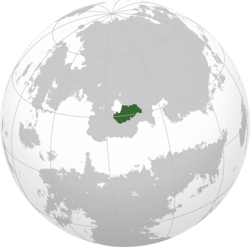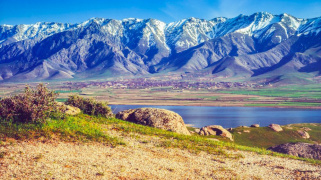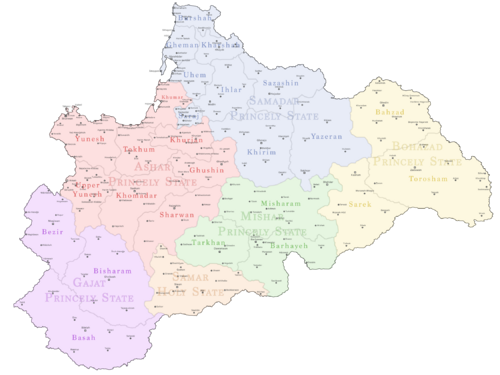Difference between revisions of "Komania"
| (12 intermediate revisions by the same user not shown) | |||
| Line 1: | Line 1: | ||
{{Infobox country | {{Infobox country | ||
|conventional_long_name = Imperial State | |conventional_long_name = Imperial State | ||
|native_name = {{small|{{cs|DAD| | |native_name = {{small|{{cs|DAD| Aşarshah}}}}<small> ([[Koman language|Koman]])</small><br>''<small>"Aşarshah"</small>''<br>{{small|{{cs|DAD|. Qoman .}}}}<br>''<small>"Khoman"</small>'' | ||
|common_name = Komania | |common_name = Komania | ||
|image_flag = Imperial | |image_flag = Imperial State Flag.png | ||
|alt_flag = <!--alt text for flag (text shown when pointer hovers over flag)--> | |alt_flag = <!--alt text for flag (text shown when pointer hovers over flag)--> | ||
|image_flag2 = <!--e.g. Second-flag of country.svg--> | |image_flag2 = <!--e.g. Second-flag of country.svg--> | ||
|alt_flag2 = <!--alt text for second flag--> | |alt_flag2 = <!--alt text for second flag--> | ||
|image_coat = | |image_coat = Imperial Seal.png | ||
|alt_coat = | |alt_coat = | ||
|symbol_type = Emblem | |symbol_type = Emblem | ||
|national_motto = '' | |national_motto = ''Teşiyaman''<br><small>''Land of a Thousand Valleys''</small> | ||
|national_anthem = '' | |national_anthem = ''Hatamagh Maşiyam ''<br><small>''The Iron March''</small> | ||
|other_symbol_type = <!--Use if a further symbol exists, e.g. hymn--> | |other_symbol_type = <!--Use if a further symbol exists, e.g. hymn--> | ||
|other_symbol = | |other_symbol = | ||
| Line 25: | Line 25: | ||
|official_languages = [[Koman language|Koman]] | |official_languages = [[Koman language|Koman]] | ||
|national_languages = | |national_languages = | ||
|regional_languages = [[Mishar language|Mishar]] · [[Balak language|Balak | |regional_languages = [[Mishar language|Mishar]] · [[Balak language|Balak]] · [[Kaatian language|Kaatian]] · [[Gushli language|Gushli]] · [[Qalar language|Qalari]] · [[Dawar language|Dawari]] | ||
|languages_type = | |languages_type = | ||
|languages = | |languages = | ||
| Line 38: | Line 38: | ||
|government_type = ''{{small|de jure:}}'' <br> Constitutional Monarchy <br> ''{{small|de facto:}}'' <br> Hybrid theocratic semi-constitutional monarchy with a federal structure | |government_type = ''{{small|de jure:}}'' <br> Constitutional Monarchy <br> ''{{small|de facto:}}'' <br> Hybrid theocratic semi-constitutional monarchy with a federal structure | ||
|leader_title1 = | |leader_title1 = Mizar (emperor) | ||
|leader_name1 = | |leader_name1 = Mişanlî Aşar | ||
|leader_title2 = Prime minister | |leader_title2 = Prime minister | ||
|leader_name2 = | |leader_name2 = Ghozan Shari | ||
|legislature = [[Koman State Assembly|State Assembly]] | |legislature = [[Koman State Assembly|State Assembly]] | ||
|upper_house = [[ | |upper_house = [[Federal Council of Komania|House of Mazans]] | ||
|lower_house = [[Imperial Council of Komania|Council of Representatives]] | |lower_house = [[Imperial Council of Komania|Council of Representatives]] | ||
|established_event1 = [[Qoman Khanate]] | |established_event1 = [[Qoman Khanate]] | ||
| Line 51: | Line 51: | ||
|established_event3 = [[Koman Principalities]] | |established_event3 = [[Koman Principalities]] | ||
|established_date3 = 12 August 1657 | |established_date3 = 12 August 1657 | ||
|established_event4 = [[Koman | |established_event4 = [[Koman Unification]] <br> proclaimed | ||
|established_date4 = 15 January 1811 | |established_date4 = 15 January 1811 | ||
|established_event5 = [[Constitution of Komania|Current Constitution]] | |established_event5 = [[Constitution of Komania|Current Constitution]] | ||
|established_date5 = 7 December | |established_date5 = 7 December 1958 | ||
|established_event6 = | |established_event6 = | ||
|established_date6 = | |established_date6 = | ||
| Line 93: | Line 93: | ||
|Gini_rank = | |Gini_rank = | ||
|Gini_year = 2016 | |Gini_year = 2016 | ||
|HDI = 0. | |HDI = 0.762 | ||
|HDI_ref = <!--(for any ref/s to associate with HDI number)--> | |HDI_ref = <!--(for any ref/s to associate with HDI number)--> | ||
|HDI_change = increase <!--increase/decrease/steady--> | |HDI_change = increase <!--increase/decrease/steady--> | ||
|HDI_rank = | |HDI_rank = | ||
|HDI_year = | |HDI_year = 2018 | ||
|currency = [[ | |currency = [[Sekham]] | ||
|currency_code = <!--ISO 4217 code/s for currency/ies (each usually three capital letters)--> | |currency_code = <!--ISO 4217 code/s for currency/ies (each usually three capital letters)--> | ||
|time_zone = SCT +3 | |time_zone = SCT +3 | ||
| Line 125: | Line 125: | ||
'''Komania''' also known as the Imperial State self-designated as ([[Koman language| Koman]]: {{cs|DAD|. Şahmêzramaz .}}; ''Şahmêzramaz'' [ʂɒh.mʲezä̌rämäz]), is a sovereign state in [[Vaniua]]. With about 42 million inhabitants, Komania is the ?-most populous country. Comprising an area of 840.440 km<sup>2</sup> making it the ? largest country in [[Vaniua]] and the ? in [[Sahar]]. [[Komania]] is bordered to the north by the [[Melkanchuta lake]], to the northeast by ? and [[Kaatkukia]], to the east by [[Balakia]], to the south by the Great Khanate of [[Gushlia]] and [[Zinsha-Vogia]], to the southwest by [[Ohania]] and finally [[Xonqorot]] and [[Shohuan]] to the west, ''Komania'' is considered to be the country with most shared borders in [[Vaniua]] followed by [[Balakia]] and [[Shohuan]]. The country's location in central [[Vaniua]] bordering the [[Melkanchuta lake]] along the flowing rivers of [[Braghak]] and [[Kashis]] give it a geostrategic importance. [[Shanvan]] is the country's capital and one of the largest economic centres of the nation only behind [[Samadar]]. | '''Komania''' also known as the Imperial State self-designated as ([[Koman language| Koman]]: {{cs|DAD|. Şahmêzramaz .}}; ''Şahmêzramaz'' [ʂɒh.mʲezä̌rämäz]), is a sovereign state in [[Vaniua]]. With about 42 million inhabitants, Komania is the ?-most populous country. Comprising an area of 840.440 km<sup>2</sup> making it the ? largest country in [[Vaniua]] and the ? in [[Sahar]]. [[Komania]] is bordered to the north by the [[Melkanchuta lake]], to the northeast by ? and [[Kaatkukia]], to the east by [[Balakia]], to the south by the Great Khanate of [[Gushlia]] and [[Zinsha-Vogia]], to the southwest by [[Ohania]] and finally [[Xonqorot]] and [[Shohuan]] to the west, ''Komania'' is considered to be the country with most shared borders in [[Vaniua]] followed by [[Balakia]] and [[Shohuan]]. The country's location in central [[Vaniua]] bordering the [[Melkanchuta lake]] along the flowing rivers of [[Braghak]] and [[Kashis]] give it a geostrategic importance. [[Shanvan]] is the country's capital and one of the largest economic centres of the nation only behind [[Samadar]]. | ||
==Etymology== | ==Etymology== | ||
The term ''Şahmêzramaz'' meaning "Imperial State" arose during the early 19th century as a common designation for the lands comprising the unified Koman Mizarates, it was initially proposed by the former Basher regime as an attempt to include non-ethnic Komans into the union. The name is often shortened to ''Şahramaz'' in unofficial documents. | |||
The name ''Koman'' ([[Koman language| Koman]]: {{cs|DAD|. Qaman .}}; ''Khaman'' ['xɒmän]) designating present-day [[Komania]] only, is a medieval term first recorded around 1150 AD by Vaniuan scholars to designate the short-lived Khanate of [[Qoman Khanate| Qoman]] suited along the southern coasts of the [[Melkanchuta lake]], it became a popular ethnonym among [[Koman people| Komans]] during the [[Great Horde]] after [[Shi Oshar]] applied the term to the newly settled [[Kalkali]] tribes of the former [[Kalkali Khanate| Kalkali state]]. It became synonymous with the term ''Qamandi'', applied to the former inhabitants of the [[Qoman Khanate]] and their language. The ethnonym "Koman" is itself of unknown origin, however, several theories suggested by prominent [[Union of Koman Studies| scholars]] pinpoint a possible origin from the Koman word ''Qama'' meaning "coast" and hypothesising the possible suffix ''-an'', ''Khaman'' might itself mean "the people of the coast" or "of the coast" itself a possible cognate to the Koman suffix -a. Other theories suggest a possible origin from the word ''Kham'' meaning "ten" historically used for the tribal confederation of [[Mestan-Kalkali Confederation| Qom]] which was itself composed by ten core tribes. | The name ''Koman'' ([[Koman language| Koman]]: {{cs|DAD|. Qaman .}}; ''Khaman'' ['xɒmän]) designating present-day [[Komania]] only, is a medieval term first recorded around 1150 AD by Vaniuan scholars to designate the short-lived Khanate of [[Qoman Khanate| Qoman]] suited along the southern coasts of the [[Melkanchuta lake]], it became a popular ethnonym among [[Koman people| Komans]] during the [[Great Horde]] after [[Shi Oshar]] applied the term to the newly settled [[Kalkali]] tribes of the former [[Kalkali Khanate| Kalkali state]]. It became synonymous with the term ''Qamandi'', applied to the former inhabitants of the [[Qoman Khanate]] and their language. The ethnonym "Koman" is itself of unknown origin, however, several theories suggested by prominent [[Union of Koman Studies| scholars]] pinpoint a possible origin from the Koman word ''Qama'' meaning "coast" and hypothesising the possible suffix ''-an'', ''Khaman'' might itself mean "the people of the coast" or "of the coast" itself a possible cognate to the Koman suffix -a. Other theories suggest a possible origin from the word ''Kham'' meaning "ten" historically used for the tribal confederation of [[Mestan-Kalkali Confederation| Qom]] which was itself composed by ten core tribes. | ||
| Line 131: | Line 135: | ||
Historically, [[Komania]] has been known through several names, as a literary tradition, poetic names have been made to designate Komania or highlight any of its peculiarities, prominent variants are ''Diəghshenden'' or ''Diəghshendeh'' meaning "land of white sand(s)" unintentionally synonymous with "land of holy sands" and ''Deşyəzen'', meaning "land of thousand valleys" which is currently used as the official motto. | Historically, [[Komania]] has been known through several names, as a literary tradition, poetic names have been made to designate Komania or highlight any of its peculiarities, prominent variants are ''Diəghshenden'' or ''Diəghshendeh'' meaning "land of white sand(s)" unintentionally synonymous with "land of holy sands" and ''Deşyəzen'', meaning "land of thousand valleys" which is currently used as the official motto. | ||
==History== | ==History== | ||
=== | ===Antiquity=== | ||
[[File:Marashah.jpg|thumb|200px|right|Ruins of Marashah, [[Samar Province|Samar]], from the 1st millennium BC, partially inhabited until 500 AD.]] | [[File:Marashah.jpg|thumb|200px|right|Ruins of Marashah, [[Samar Province|Samar]], from the 1st millennium BC, partially inhabited until 500 AD.]] | ||
The | The present-day lands of Komania once formed part of a ligature of pre-Vaniuan cultures, most dating back to 4000 BCE starting with the Black-Pottery culture, major settlements such as Masaṭar (modern Samadar) contributed heavily on Vaniua’s early agricultural development. The Black-Pottery culture would, later on, develop into a series of city-states, from which early urbanisation arose. A large network of settlements comprising the pre-Vaniuan states of Ghashar and Uruk developed which marked notable traces of complex architecture within the Golden Crescent of Vaniua. | ||
Renown Khomani experts have been able to trace considerable linguistic development within the region, during excavations held in 1890 archaeologist Shajali Wazghan uncovered a series of clay tablets pertaining to the Ghashar civilisation, this discovery enabled the reconstruction of a large substrate of surviving words in the Khomani language. | |||
=== | [[File:Ghoraman.jpg|thumb|200px|right|Ghoraman, [[Khurjan Province|Khurjan]], a major pre-Vanuian settlement, 100 BC.]] | ||
===Early Vaniuan migrations=== | |||
By 2000 BCE a large portion of south and eastern Vaniua became subject to raids from proto-Vaniuans, which at this stage were heavily nomadic and had begun an early process of ethnogenesis. Due to a warmer climate, large portions of arable land were gradually rendered infertile, combined by a gradual displacement from proto-Vaniuans most pre-Vaniuans were pushed from their settlements and slowly reduced into pockets, this change marked a definitive shift of demographics across Vaniua. It is estimated that by 1000 BCE Vaniuans formed the majority of the region. | |||
A question of whether such demographic displacement came by means of assimilation or tribal violence is still in debate. A large portion of archaeological evidence, however, suggest at least an initial clash between sedentary pre-Vaniuans and the more nomadic proto-Vaniuans. | |||
===Medieval Period=== | ===Medieval Period=== | ||
| Line 181: | Line 184: | ||
===Cities, provinces and regions === | ===Cities, provinces and regions === | ||
==Politics== | ==Politics== | ||
The government of the Imperial State is based on the 1958 constitution, following several coups in the 19th and 20th century, Komania has seen the instalment of various monarchical regimes, all following various forms of ideology. Due to the theocratic nature of the Ashar dynasty, politics within the country have been heavily influenced by theological and unsecular practices, with no formal distinction in the current constitution. Attempts on secularising the government have all but failed, mostly due to the ''Kharem Haz'' “law of balance” a transpolitical doctrine promoted by the Fukhdar regime. | |||
===Administrative divisions=== | ===Administrative divisions=== | ||
Revision as of 16:48, 8 June 2020
| Imperial State |
||||||
|---|---|---|---|---|---|---|
|
||||||
| Motto: Teşiyaman Land of a Thousand Valleys |
||||||
| Anthem: Hatamagh Maşiyam The Iron March |
||||||
| Capital | Shanvan | |||||
| Largest city | Samadar | |||||
| Official languages | Koman | |||||
| Recognised regional languages | Mishar · Balak · Kaatian · Gushli · Qalari · Dawari | |||||
| Ethnic groups | Koman (88 %) Other (11 %) |
|||||
| Religion | Zarasaism Other recognized religions: Pauegism · Iovism |
|||||
| Demonym | Koman | |||||
| Government | de jure: Constitutional Monarchy de facto: Hybrid theocratic semi-constitutional monarchy with a federal structure |
|||||
| - | Mizar (emperor) | Mişanlî Aşar | ||||
| - | Prime minister | Ghozan Shari | ||||
| Legislature | State Assembly | |||||
| - | Upper house | House of Mazans | ||||
| - | Lower house | Council of Representatives | ||||
| Establishment | ||||||
| - | Qoman Khanate | c.1180-1280 | ||||
| - | Great Horde | 6 May 1289 | ||||
| - | Koman Principalities | 12 August 1657 | ||||
| - | Koman Unification proclaimed |
15 January 1811 | ||||
| - | Current Constitution | 7 December 1958 | ||||
| Area | ||||||
| - | 840.440 km2 324 sq mi |
|||||
| - | Water (%) | 1.8% | ||||
| Population | ||||||
| - | 2016 estimate | 42,904,651 |
||||
| - | Density | 51/km2 132.1/sq mi |
||||
| GDP (PPP) | 2016 estimate | |||||
| - | Total | 740 billion | ||||
| - | Per capita | 11,677 | ||||
| GDP (nominal) | 2016 estimate | |||||
| - | Total | 546.7 billion | ||||
| - | Per capita | 7,250 | ||||
| Gini (2016) | 46 high |
|||||
| HDI (2018) | high |
|||||
| Currency | Sekham | |||||
| Time zone | SCT +3 | |||||
| - | Summer (DST) | not observed (SCT) | ||||
| Date format | yyyy/mm/dd ( SH) | |||||
| Drives on the | right | |||||
| Calling code | +11 | |||||
| Internet TLD | .km, .km | |||||
| Part of a series on |
| Vaniuans |
|---|
| Nations |
Non-independent regions
Former nations
Balak Empire Baysanid Khanate Federated Kingdom Great Horde Holy Shanyedate Kothlen Horde Shomosvan Tamisang Hojanate Torosh Khanate Uhimid Hojanate Vos State |
| Languages |
| Religions |
| Other |
Komania also known as the Imperial State self-designated as ( Koman: . Şahmêzramaz .; Şahmêzramaz [ʂɒh.mʲezä̌rämäz]), is a sovereign state in Vaniua. With about 42 million inhabitants, Komania is the ?-most populous country. Comprising an area of 840.440 km2 making it the ? largest country in Vaniua and the ? in Sahar. Komania is bordered to the north by the Melkanchuta lake, to the northeast by ? and Kaatkukia, to the east by Balakia, to the south by the Great Khanate of Gushlia and Zinsha-Vogia, to the southwest by Ohania and finally Xonqorot and Shohuan to the west, Komania is considered to be the country with most shared borders in Vaniua followed by Balakia and Shohuan. The country's location in central Vaniua bordering the Melkanchuta lake along the flowing rivers of Braghak and Kashis give it a geostrategic importance. Shanvan is the country's capital and one of the largest economic centres of the nation only behind Samadar.
Etymology
The term Şahmêzramaz meaning "Imperial State" arose during the early 19th century as a common designation for the lands comprising the unified Koman Mizarates, it was initially proposed by the former Basher regime as an attempt to include non-ethnic Komans into the union. The name is often shortened to Şahramaz in unofficial documents.
The name Koman ( Koman: . Qaman .; Khaman ['xɒmän]) designating present-day Komania only, is a medieval term first recorded around 1150 AD by Vaniuan scholars to designate the short-lived Khanate of Qoman suited along the southern coasts of the Melkanchuta lake, it became a popular ethnonym among Komans during the Great Horde after Shi Oshar applied the term to the newly settled Kalkali tribes of the former Kalkali state. It became synonymous with the term Qamandi, applied to the former inhabitants of the Qoman Khanate and their language. The ethnonym "Koman" is itself of unknown origin, however, several theories suggested by prominent scholars pinpoint a possible origin from the Koman word Qama meaning "coast" and hypothesising the possible suffix -an, Khaman might itself mean "the people of the coast" or "of the coast" itself a possible cognate to the Koman suffix -a. Other theories suggest a possible origin from the word Kham meaning "ten" historically used for the tribal confederation of Qom which was itself composed by ten core tribes.
The self-designation Tamyiran meaning "from Tamayir" begun to be used around the 16th century to refer to the Koman diaspora throughout the Great Horde, composed by the ethnonym Tamir and the suffixes -yir meaning -an, an archaic suffix meaning "people of" or "land of" it was at the time exclusively used to refer to any territory inhabited by tribes of Tamayir origin and the Kalkali Khanate in general.
Historically, Komania has been known through several names, as a literary tradition, poetic names have been made to designate Komania or highlight any of its peculiarities, prominent variants are Diəghshenden or Diəghshendeh meaning "land of white sand(s)" unintentionally synonymous with "land of holy sands" and Deşyəzen, meaning "land of thousand valleys" which is currently used as the official motto.
History
Antiquity
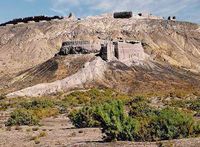
The present-day lands of Komania once formed part of a ligature of pre-Vaniuan cultures, most dating back to 4000 BCE starting with the Black-Pottery culture, major settlements such as Masaṭar (modern Samadar) contributed heavily on Vaniua’s early agricultural development. The Black-Pottery culture would, later on, develop into a series of city-states, from which early urbanisation arose. A large network of settlements comprising the pre-Vaniuan states of Ghashar and Uruk developed which marked notable traces of complex architecture within the Golden Crescent of Vaniua.
Renown Khomani experts have been able to trace considerable linguistic development within the region, during excavations held in 1890 archaeologist Shajali Wazghan uncovered a series of clay tablets pertaining to the Ghashar civilisation, this discovery enabled the reconstruction of a large substrate of surviving words in the Khomani language.

Early Vaniuan migrations
By 2000 BCE a large portion of south and eastern Vaniua became subject to raids from proto-Vaniuans, which at this stage were heavily nomadic and had begun an early process of ethnogenesis. Due to a warmer climate, large portions of arable land were gradually rendered infertile, combined by a gradual displacement from proto-Vaniuans most pre-Vaniuans were pushed from their settlements and slowly reduced into pockets, this change marked a definitive shift of demographics across Vaniua. It is estimated that by 1000 BCE Vaniuans formed the majority of the region.
A question of whether such demographic displacement came by means of assimilation or tribal violence is still in debate. A large portion of archaeological evidence, however, suggest at least an initial clash between sedentary pre-Vaniuans and the more nomadic proto-Vaniuans.
Medieval Period
Early Modern Period
Era of Industrialisation
Militarisation
Koman Civil War
Sannist Rebellion
Kuulist Threat
Contemporary Era
Geography
"Sand castles" in Hakmara Desert, Samar.
Located in the near centre of the Vaniuan region, Komania is considered a landlocked country, sharing the Melkanchuta lake with Dohjan the country extends itself along the Vaniuan plateau with a total area of 814.130km2.
Climate
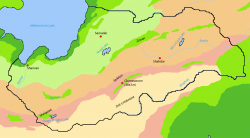
Fauna
Cities, provinces and regions
Politics
The government of the Imperial State is based on the 1958 constitution, following several coups in the 19th and 20th century, Komania has seen the instalment of various monarchical regimes, all following various forms of ideology. Due to the theocratic nature of the Ashar dynasty, politics within the country have been heavily influenced by theological and unsecular practices, with no formal distinction in the current constitution. Attempts on secularising the government have all but failed, mostly due to the Kharem Haz “law of balance” a transpolitical doctrine promoted by the Fukhdar regime.
Administrative divisions
| Name | Capital/Administrative center | Flag | Area (km2) |
Population |
|---|---|---|---|---|
| Abkhar | TBD | [[File:|border|45x45px]] | TBD | TBD |
| Aghaz | TBD | [[File:|border|45x45px]] | TBD | TBD |
| Ashardan | TBD | [[File:|border|45x45px]] | TBD | TBD |
| Badar | TBD | [[File:|border|45x45px]] | TBD | TBD |
| Bahzad | TBD | [[File:|border|45x45px]] | TBD | TBD |
| Barhayah | TBD | [[File:|border|45x45px]] | TBD | TBD |
| Bishardan | TBD | [[File:|border|45x45px]] | TBD | TBD |
| Ghashan | TBD | [[File:|border|45x45px]] | TBD | TBD |
| Ihlar | TBD | [[File:|border|45x45px]] | TBD | TBD |
| Mishardan | Shahdar | TBD | TBD | |
| Qazsar | Samadar | TBD | TBD | |
| Sadar | TBD | [[File:|border|45x45px]] | TBD | TBD |
| Samar | TBD | [[File:|border|45x45px]] | TBD | TBD |
| Shanwan | Shanvan | TBD | TBD | |
| Sharwan | TBD | [[File:|border|45x45px]] | TBD | TBD |
| Tarkhan | TBD | [[File:|border|45x45px]] | TBD | TBD |
| Toroshdan | TBD | [[File:|border|45x45px]] | TBD | TBD |
| Ushghan | TBD | [[File:|border|45x45px]] | TBD | TBD |
| Yazeran | TBD | [[File:|border|45x45px]] | TBD | TBD |
| Zasad | TBD | [[File:|border|45x45px]] | TBD | TBD |
Military
Economy
Transport
Energy
Science and technology
Tourism
Demographics
Ethnic groups
Urbanisation
Language
Education
Healthcare
Religion
Culture
Heritage
Architecture



